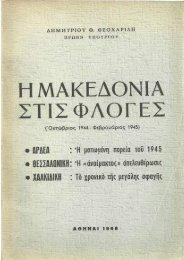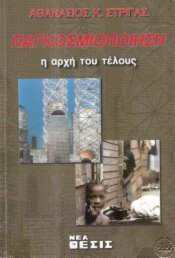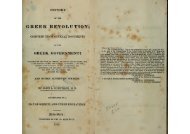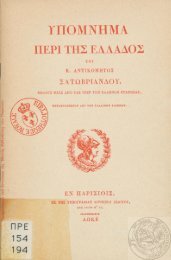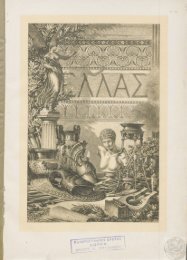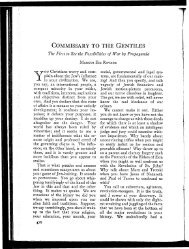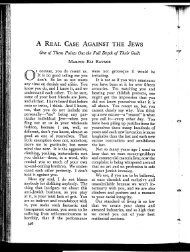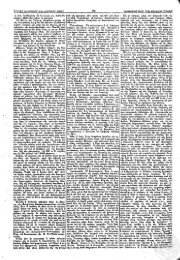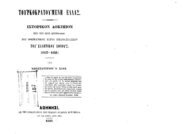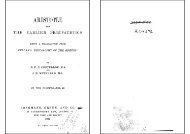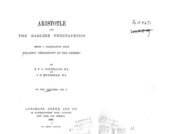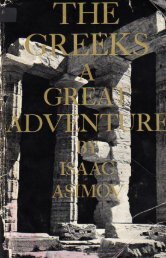- Page 1 and 2:
THE OF EARLY AGE GREECE WILLIAM RID
- Page 3 and 4:
VIU PREFACE. I have endeavoured to
- Page 5 and 6:
CONTENTS. CHAPTER I. I'AOE The Rema
- Page 7 and 8:
. . LIST OF ILLUSTRATIONS. XVI LIST
- Page 9 and 10:
PREHISTORIC REMAINS AND THEIR DISTR
- Page 11 and 12:
PREHISTORIC REMAINS AND THEIR DISTR
- Page 13 and 14:
PREHISTORIC REMAINS AND THEIR DISTR
- Page 15 and 16:
PREHISTORIC REMAINS AND THEIR DISTR
- Page 17 and 18:
PREHISTORIC REMAINS AND THEIR DISTR
- Page 19 and 20:
' The . 24 PREHISTORIC REMAINS AND
- Page 21 and 22:
: he ' )>. cil.. pp. 1 11 Fra/cr, .
- Page 23 and 24:
' ' 32 PREHISTORIC REMAINS AND THEI
- Page 25 and 26:
' ' PREHISTORIC REMAINS AND THEIR D
- Page 27 and 28:
' ' PREHISTORIC REMAINS AND THEIR D
- Page 29 and 30:
' ' ' PREHISTORIC REMAINS AND THEIR
- Page 31 and 32:
PREHISTORIC REMAINS AND THEIR DISTR
- Page 33 and 34:
' This PREHISTORIC REMAINS AND THEI
- Page 35 and 36:
PREHISTORIC REMAINS AND THEIR DISTR
- Page 37 and 38:
' ' '' -* PREHISTORIC REMAINS AND T
- Page 39 and 40:
' A. 64 PREHISTORIC REMAINS AND THE
- Page 41 and 42:
PREHISTORIC REMAINS AND THEIR DISTR
- Page 43 and 44:
' he PREHISTORIC REMAINS AND THEIR
- Page 45 and 46:
PREHISTORIC REMAINS AND THEIR DISTR
- Page 47 and 48:
'' PREHISTORIC REMAINS AND THEIR DI
- Page 49 and 50:
" WHO WERE THE MAKERS ? 83 But even
- Page 51 and 52:
WHO WERE THE MAKERS ? 87 88 ' ' ' X
- Page 53 and 54:
I WHO WERE THE MAKERS ? 91 92 C(. S
- Page 55 and 56:
' ' ' WHO WERE THE MAKERS? 95 write
- Page 57 and 58:
WHO WERE THE MAKERS ? 99 sent him t
- Page 59 and 60:
' ' WHO WERE THE MAKERS ? 103 the w
- Page 61 and 62:
' WHO WERE THE MAKERS ? 107 to clai
- Page 63 and 64:
favdaaovTai ' WHO WERE THE MAKERS ?
- Page 65 and 66:
' WHO WERE THE MAKERS ? 115 only fa
- Page 67 and 68:
"it WHO WERE THE MAKERS? 119 in the
- Page 69 and 70:
" WHO WERE THE MAKERS? 123 124 WHO
- Page 71 and 72:
and WHO WERE THE MAKERS ? 127 natio
- Page 73 and 74:
' WHO WERE THE MAKERS ? 131 power o
- Page 75 and 76:
WHO WERE THE MAKERS ? 135 136 WHO W
- Page 77 and 78:
WHO WERE THE MAKERS ? 139 origin of
- Page 79 and 80:
' WHO WERE THE MAKERS ? 143 majorit
- Page 81 and 82:
WHO WERE THE MAKERS ? 147 People ma
- Page 83 and 84:
' WHO WERE THE MAKERS ? 151 WHO WER
- Page 85 and 86:
' WHO WERE THE MAKERS ? 155 synagog
- Page 87 and 88:
WHO WERE THE MAKERS ? 159 therefore
- Page 89 and 90:
' ' WHO WERE THE MAKERS ? 163 Aegin
- Page 91 and 92:
' ' WHO WERE THE MAKERS ? 167 168 H
- Page 93 and 94:
' WHO WERE THE MAKERS? 171 Achean s
- Page 95 and 96:
WHO WERE THE MAKERS? 175 A more rea
- Page 97 and 98:
WHO WERE THE MAKERS ? 179 from Arca
- Page 99 and 100:
WHO WERE THE MAKERS? 183 the outcom
- Page 101 and 102:
' ' WHO WERE THE MAKERS ? 187 a son
- Page 103 and 104:
WHO WERE THE MAKERS ? 191 of the is
- Page 105 and 106:
WHO WERE THE MAKERS ? 195 guistic e
- Page 107 and 108:
Having slain the aged Licymnius, WH
- Page 109 and 110:
' ' WHO WERE THE MAKERS ? 203 of Da
- Page 111 and 112:
WHO WERE THE MAKERS ? 207 Peloponne
- Page 113 and 114:
' WHO WERE THE MAKERS ? 211 212 WHO
- Page 115 and 116:
WHO WERE THE MAKERS ? 215 216 WHO W
- Page 117 and 118:
WHO WERE THE MAKERS? 219 Epaphus, t
- Page 119 and 120:
' -' ' ' ' liilivans as it is hy th
- Page 121 and 122:
WHO WERE THE MAKERS ? 227 its north
- Page 123 and 124:
WHO WERE THE MAKERS ? 231 Thus we h
- Page 125 and 126:
people - Monti'lius. oji. cit., I'l
- Page 127 and 128:
' they WHO WERE THE MAKERS ? 239 As
- Page 129 and 130:
' WHO WERE THE MAKERS ? 243 The bro
- Page 131 and 132:
WHO WERE THE MAKERS ? 247 The Caere
- Page 133 and 134:
' WHO WERE THE MAKERS? 251 their ow
- Page 135 and 136:
'' I vm. WHO WERE THE MAKERS ? 255
- Page 137 and 138:
' ls'.)S), ' ' WHO WERE THE MAKERS
- Page 139 and 140:
' ' Ann. WHO WERE THE MAKERS ? 263
- Page 141 and 142:
' WHO WERE THE MAKERS ? 267 then be
- Page 143 and 144:
' WHO WERE THE MAKERS ? 271 blades,
- Page 145 and 146:
' ' Oil WHO WERE THE MAKERS? 275 Th
- Page 147 and 148:
' WHO WERE THE MAKERS? 279 erected
- Page 149 and 150:
' ' ' 284 WHO WERE THE MAKERS ? WHO
- Page 151 and 152:
WHO WERE THE MAKERS ? 287 must susp
- Page 153 and 154:
WHO WERE THE MAKERS ? 291 Achean Ph
- Page 155 and 156:
' .Icvons 296 THE HOMERIC AGE. p. T
- Page 157 and 158:
' THE HOMERIC AGE. 299 fastened wit
- Page 159 and 160:
' THE HOMERIC AGE. 303 through the
- Page 161 and 162:
'' THE HOMERIC AGE. 307 dead, was a
- Page 163 and 164:
' '' '" ' THE HOMERIC AGE. 311 and
- Page 165 and 166:
THE HOMERIC AGE. 315 from under the
- Page 167 and 168:
' eu THE HOMERIC AGE. 319 not worn
- Page 169 and 170:
' 324 THE HOMERIC AGE, in douhtful
- Page 171 and 172:
' -' ' '' THE HOMERIC AGE. 327 But,
- Page 173 and 174:
THE HOMERIC AGE. 331 332 THE HOMERI
- Page 175 and 176:
THE HOMERIC AGE. 335 strungly devel
- Page 177 and 178:
WHENCE CAME THE ACHEANS ? 339 is of
- Page 179 and 180:
advance southwards of tribes WHENCE
- Page 181 and 182:
' WHENCE CAME THE ACHEANS ? 347 a r
- Page 183 and 184:
352 WHENCE CAME THE ACHEANS ? WHENC
- Page 185 and 186:
WHENCE CAME THE ACHEANS ? 355 From
- Page 187 and 188:
' WHENCE CAME THE ACHEANS ? 359 360
- Page 189 and 190:
: WHENCE CAME THE ACHEANS ? 363 tha
- Page 191 and 192:
' ' WHENCE CAME THE ACHEANS ? 367 a
- Page 193 and 194:
' ' ' WHENCE CAME THE ACHEANS ? 371
- Page 195 and 196:
' WHENCE CAME THE ACHEANS ? 375 WHE
- Page 197 and 198:
' WHENCE CAME THE ACHEANS ? 379 380
- Page 199 and 200:
' WHENCE CAME THE ACHEANS ? 383 For
- Page 201 and 202:
' ' ' ' WHENCE CAME THE ACHEAXS ? 3
- Page 203 and 204:
' -^ WHENCE CAME THE ACHEANS ? 391
- Page 205 and 206:
' Herod. WHENCE CAME THE ACHEAX8 ?
- Page 207 and 208:
' WHENCE CAME THE AOHEANS ? 399 sam
- Page 209 and 210:
' "* who ' advanced into southern R
- Page 211 and 212:
' ' 408 THE EARLY IRON AGE IN EUROP
- Page 213 and 214:
' ' THE EARLY IROX AGE IN EUROPE. 4
- Page 215 and 216:
' THE EARLY IRON AGE IX EUROPE. 415
- Page 217 and 218:
' Von THE EARLY IRON AGE IX EUROPE.
- Page 219 and 220:
' I THE EARLY IRON AGE IN EUROPE. 4
- Page 221 and 222:
428 THE EARLY IRON AGE IN EUROPE. l
- Page 223 and 224:
THE EARLY IRON AGE IN EUROPE. 431 T
- Page 225 and 226:
' ' Mittlt. -' THE EARLY IRON AGE I
- Page 227 and 228:
' ' ' Munio. THE EARLY IRON AGE IN
- Page 229 and 230:
' ' ' THE EARLY IRON AGE IX EUROPE.
- Page 231 and 232:
' THE EARLY IRON AGE IN EUROPE. 447
- Page 233 and 234:
-' THE EARLY IRON AGE IX EUROPE. 45
- Page 235 and 236: THE ROUND SHIELD. 455 ioG THE ROUND
- Page 237 and 238: ' THE ROUND SHIELD. 459 460 THE ROU
- Page 239 and 240: -' THE ROUND SHIELD. 463 Nor was it
- Page 241 and 242: ' THE ROUND SHIELD. 467 Phrygian fa
- Page 243 and 244: THE ROUND SHIELD. 471 At Caere not
- Page 245 and 246: ' Head, THE ROUND SHIELD. 475 476 T
- Page 247 and 248: ' THE HOUND SHIELD. 479 a hollow tr
- Page 249 and 250: "' ' IXHUMATION, CREMATION, AND THE
- Page 251 and 252: ' '' INHUMATION, CREMATION, AND THE
- Page 253 and 254: ' '' ' - ' ' INHUMATION, CREMATION,
- Page 255 and 256: INHUMATION, CREMATION, AND THE SOUL
- Page 257 and 258: ' ' Mmii... ' ' INHUMATION, CREMATI
- Page 259 and 260: ' ' ' INHUMATION, CREMATION, AND TH
- Page 261 and 262: I I INHUMATION, CREMATION, AND THE
- Page 263 and 264: ' ' 512 INHUMATION, CKEMATION, AND
- Page 265 and 266: ' ' INHUMATION, CREMATION, AND THE
- Page 267 and 268: ' INHUMATION, CREMATION, AND THE SO
- Page 269 and 270: ' W. ' INHUMATION, CREMATION, AND T
- Page 271 and 272: ' ami " ' INHUMATION, CHEMATIOX, AN
- Page 273 and 274: ' '' ' INHUMATION, CREMATION, AND T
- Page 275 and 276: ' ' INHUMATION, CREMATION, AND THE
- Page 277 and 278: ' INHUMATION, CREMATION, AND THE SO
- Page 279 and 280: ' ' ' INHUMATION, CREMATION, AND TH
- Page 281 and 282: INHUMATION, CREMATION, AND THE SOUL
- Page 283 and 284: INHUMATION, CREMATION, AND THE SOUL
- Page 285: THE BROOCH. 555 556 THE BROOCH, The
- Page 289 and 290: ' Hen ' ' "' ' THE BROOCH. 563 From
- Page 291 and 292: THE BROOCH. 567 knob-shaped appenda
- Page 293 and 294: ' THE BROOCH. 571 a few sporadic im
- Page 295 and 296: ' Much, THE BROOCH. 577 how it is t
- Page 297 and 298: THE BROOCH. 579 Greece, are likewis
- Page 299 and 300: ' O'CmiT. ' THE BROOCH. 583 gold fr
- Page 301 and 302: ' ' ' THE BROOCH. 587 Buckinghamshi
- Page 303 and 304: ' A "' ' THE BROOCH. 591 We have he
- Page 305 and 306: ' ' IRON. 595 never lead to any but
- Page 307 and 308: IRON. 599 It is therefore much more
- Page 309 and 310: ' IRON. 603 was a great scarcity of
- Page 311 and 312: '' IRON. 607 iron came likewise fro
- Page 313 and 314: ' ' IRON. Oil 612 IRON. time afford
- Page 315 and 316: ' IRON. 615 Egypt, and not the reve
- Page 317 and 318: ' IRON. G19 620 IRON. It is possibl
- Page 319 and 320: I ' IRON. 623 Siderotektones\ but h
- Page 321 and 322: '' -' IRON. 627 628 IRON. infers th
- Page 323 and 324: ' ' 632 THE HOMERIC DIALECT. Odysse
- Page 325 and 326: ' THE HOMERIC DIALECT. 635 Mr Andre
- Page 327 and 328: THE HOMERIC DIALECT. 639 youths unw
- Page 329 and 330: ' THE HOMERIC DIALECT. 643 material
- Page 331 and 332: I THE HOMERIC DIALECT. 647 648 THE
- Page 333 and 334: Herod, l)iod. Sic. (III. ')'! H) sa
- Page 335 and 336: wicii ' ' THE HOMERIC DIALECT, 655
- Page 337 and 338:
' ' THE HOMERIC DIALECT. 659 Closel
- Page 339 and 340:
THE HOMERIC DIALECT. 663 664 THE HO
- Page 341 and 342:
' " ' a" THE HOMERIC ]>IALECT. 667
- Page 343 and 344:
' W. ' THE HOMERIC DIALECT. 671 672
- Page 345 and 346:
ui ll^ pmni iila- i . ^pi el ivrl\
- Page 347 and 348:
fed THE HOMERIC DIALECT. 679 680 TH
- Page 349:
THE HOMERIC DIALECT. 683 spite of c



